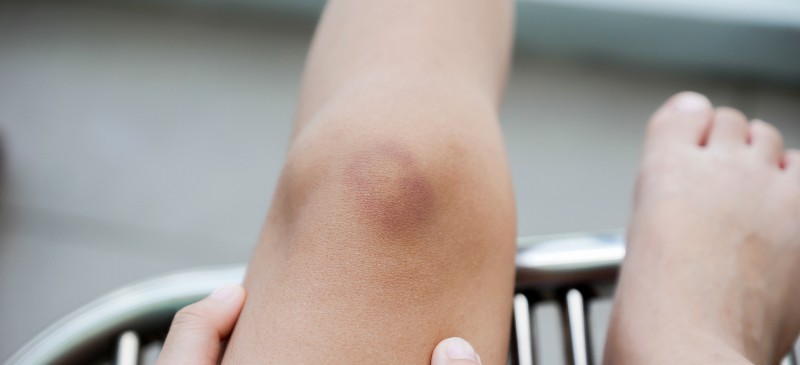
852035814 accident, aggregation, beaten, body, caucasian, contusion, discoloration, disease, effect, health, hematoma, hurt, infection, inhibitor, injury, medical, painful, person, pharmaceutical, prevent, scratch, services, side, stop, trauma, treatment Large hematoma, a bruise on the arm in patient that taken platelet aggregation inhibitor drug on pharmacy background.
Have you ever had a fall, got hit, tripped, or fallen off a bike sometime in your life? It is most likely that everyone had at least one occurrence of a traumatic event, be it major or minor. From these unfortunate events, we must have noticed the development of blue-black or purplish discolouration of our skin at the site of impact. This bruise or ecchymosis in medical terminology is a condition where blood seeps out from damaged blood vessels from any injury and collects just beneath the skin.
Bruises can happen at various depths under the skin depending on the mechanism of injury or the actual cause of the bruise. A bruise can be found immediately under the skin, in the fatty layer, in the muscle, under the muscle, or over the bone. Bruises can also happen due to reasons other than physical damage. A bruise that appears spontaneously or with minimal injury could be a sign of an underlying disease, or due to medication. Someone with bleeding disorders such as haemophilia, idiopathic thrombocytopenic purpura, leukaemia, or those taking warfarin are all susceptible to developing bruises. Worthy of note is unexplained bruises in children, should raise a particular concern and needs to be identified by a doctor, for fear of a serious illness or a case of abuse.
In order for us to get into deep bruise treatment, we need to know the different stages a bruise goes through. Generally, there are four stages. The first stage is immediately after impact, where fresh blood collects under the skin, giving it the reddish hue with or without swelling. The next few days, the blood turns to dark blue and purplish due to lack of oxygen. Nearing a week, the third stage involves the blood components’ breakdown, giving it a greenish tinge. The last stage is when the bruise fades to brown or yellow before completely fades away to blend seamlessly with the surrounding skin. Typically a bruise resolves in 2 weeks, but it can be later or earlier depending on the severity of injury, size and other factors.
Can we help speed the healing process? Are they easy?
The answers to these is a resounding yes. Listed below are the remedies you can try at home and for best results you can contact the expertise doctor:

Ice therapy and heat therapy
Some people may be confused by the application of these therapies. When should we apply ice or warm compress and why? Generally, on impact, the first cold or warm compress we want to give is a cold compress. The cold temperature will constrict the blood vessels, greatly limiting the spill of blood and swelling, and the cold serves as a numbing agent, reducing the pain you are having.
Once the bruise has settled, the swelling is not growing, a warm compress will promote faster healing by improving blood circulation at the site.
Compression bandage
The bruised area ideally should be wrapped with an elastic bandage. The even pressure exerted on the bruised site will help limit the leaking vessels and capillaries, reducing swelling and pain. Swelling should be minimised because it stretches the fine nerve endings and elicits pain.
Limb elevation
Elevating the bruised site above the heart level will promote better drainage of blood and fluid away, effectively reducing pressure, swelling and pain at the site of injury.
Vitamin C and K application
Vitamin C which can be found in many forms, from ingestibles to topical creams has great anti-inflammatory properties that promote faster-wound healing.
Vitamin K is needed for blood clotting mechanism, and a small study revealed that vitamin K reduces the severity of bruising. This can be achieved by rubbing vitamin K cream onto the bruise twice daily.
Aloe vera
Revered for its soothing and anti-inflammatory properties, it can help reduce pain and inflammation when applied topically.
Bruises usually go away on its own and are generally harmless. However, do take particular attention if a lump develops over the bruise, worsening pain or enlargement of the bruise, frequent or spontaneous bruising, and presence of blood in the urine or stool. These should prompt you to seek expert help right away. Keep in mind also that a bruise with excruciating pain that doesn’t go away could mean a fracture and should not be ignored.
Jeff Morgan is currently associated with NetworksGrid as a technical content writer. Through his long years of experience in the IT industry, he has mastered the art of writing quality, engaging and unique content related to IT solutions used by businesses.
